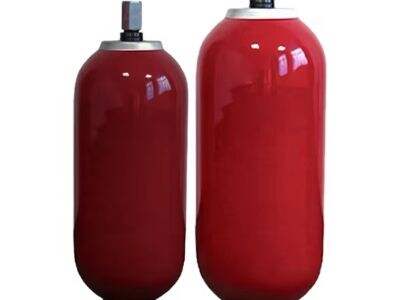Accumulators are like the machine’s secret helpers. They are energy sponges, soaking up energy and then spilling it when we ask for it, or when we don’t.” Accumulators come in three varieties: bladder, piston, and diaphragm. Each type operates differently and they have their pros and cons.
Operation of Bladder, Piston, and Diaphragm Accumulators:
Bladder type accumulator: These contain a flexible rubber bladder in which fluid is stored. When pressure increases, the fluid forces the bladder to squeeze, storing energy. When pressure drops, the bladder expels the fluid so the machine can operate.
Piston Accumulators: They involve a piston to separate the fluid and gas. When pressure rises, the gas compresses, doing the work of storing energy. When pressure drops, the gas pushes the piston to release the energy.
Diaphragm Accumulators: They comprise a flexing diaphragm for isolating the fluid from the gas. When pressure rises, the gas squeezes, storing energy. As the pressure drops, the gas pushes the diaphragm down, releasing energy.
Pros and Cons of Both Types:
Bladder Accumulators: They are compact and lightweight, so you can install them anywhere. However, they can be prone to temperature sensitivity and may require frequent fixing.
Piston Accumulators: These are durable and pressure tolerant. But they are heavier and more complex, which could complicate repairs.
Diaphragm Bladders: Very efficient and reliable. However, they may not carry as much duty cycle as a piston accumulator.
Compare the performance of different accumulators:
Bladder Accumulators: Suitable for applications that require rapid response, such as in construction equipment. But they might not be effective in very high-pressure situations.
Piston Accumulators: They work well in high-pressure situations, or with large machinery. They can deliver more power, but can be slower in modulating pressure change.
Diaphragm Accumulators: These are the most flexible and can be employed for many tasks. They're space-efficient and reliable and therefore a solid option for a lot of machines.
Selecting the Appropriate Accumulator:
When choosing an accumulator for your machine, consider the pressure, flow rate, and the speed that it needs to respond. Bladder accumulators are suitable for fast response, piston accumulators for high pressure, and diaphragm accumulator in many applications.
Key Differences Between Types of School:
They’re small and light, and easier to mount, but may require some internal fixing. Piston accumulators are robust and can handle high pressure but are also heavier and more intricate. Diaphragm accumulators are efficient and reliable but may lack the longevity of the piston accumulator. Each kind has its pluses and its minuses, so you’ll want to select the right category for your purposes.



